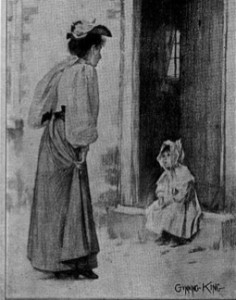The year 2012 was identified as marking 150 years since the start of health visiting in 1862, but the profession’s early days were not clearly documented.

Nineteenth century ladies sanitary inspector (one of the first health visitors).
There had been a plethora of different home visiting initiatives, of which many stemmed from religious and philanthropic imperatives, whilst others came from new and developing ideas from within nursing. So, why choose 1862 as the start of the profession – what was it that made that year stand out?
There were huge public health needs and multiple initiatives and projects, of which some lasted and flourished, whilst others foundered or went out of fashion. The Manchester and Salford Sanitary Reform Association was set up in 1852, with a Ladies Branch that began in 1860. The Ladies Branch reports were not published annually until 1880, but contemporary journals and news reports detailed their early work (Heggie 2011).
The Ladies chose to concentrate on disseminating health knowledge among women and children, focusing on practical education and help. To achieve this, in 1862 they decided to employ a respectable working woman to visit the homes of the poor and ‘assist in promoting comfort, urging the importance of cleanliness, thrift and temperance on all occasions’ (Hardie 1893, page 9).
This initiative is usually cited as the start of health visiting (Dingwall 1977), for several reasons:
- There is a direct, unbroken line from that date, to the current health visiting service, unlike the many other earlier (and later) home visiting initiatives that came and went through the Victorian era. Reports vary about when the first health visitors were actually employed, but the decision was made in 1862, and by 1867 there was a record of the workers in post (Heggie 2011).
- The health visitors were paid workers, employed by the charity. They were not volunteers, although the Ladies who set up and managed the scheme were, at least until the service became formalised in the early twentieth century. This was a clear departure from the many other charitable visiting schemes in Victorian times (Davies 1988), and was remarkable for forging a way into the workplace for women from both working and middle class backgrounds.
- It was separate and different to nursing, being the first service ‘which clearly exemplified the idea of a health visitor as someone who delivered advice and counsel rather than nursing care for the indigent sick’ (Dingwall 1977, page 292). Florence Nightingale wrote: ‘It hardly seems necessary to contrast sick nursing with this (health visiting). The needs of home health bringing require different but not lower qualifications and are more varied. She (the health visitor) must create a new work and a new profession for women,’ (Nightingale 1891).
The decision, 150 years ago to employ a working woman to visit women and children in their homes to help improve their health, heralded the start of an enduring profession.
We are witnessing a resurgence of the health visiting in 2012, still with the same focus on providing universal and practical support, but now with a renewed emphasis on research evidence, acceptability to parents and high standards of professional practice.
References
Davies, C. (1988) The health visitor as mother’s friend: a woman’s place in public health, 1900 – 1914. Social History of Medicine, 1: 39–59.
Dingwall, R. (1977) Collectivism, regionalism and feminism: health visiting and British Social Policy 1850-1975. Journal of Social Policy. 6: 3, 291-315.
Hardie, E. (1893) The Ladies Health Society of Manchester and Salford (digital version accessed 03-03-12)
Heggie, V. (2011) Health Visiting and District Nursing in Victorian Manchester; divergent and convergent vocations. Women’s History Review, 20: 3, 403-422
Nightingale, F. (1891) Letter to Mr Frederick Verney, cited in Owen G (ed) (1974) Health Visiting (page 5) London: Bailliere Tindall
If you do not have access to Paediatrics and Child Health journal, you can read the full-text via the author’s pre-publication PDF, shared with consent from Elsevier, here.







